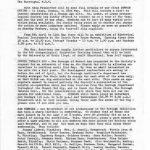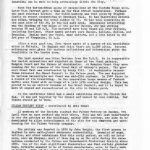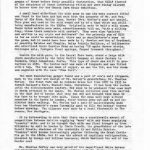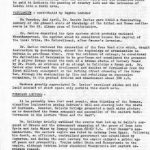Newsletter
Page 1
Members may like to know that the chair at the Annual General Meeting on 7th May will be taken by our Vice-President, Miss Daisy Hill. A full evening’s programme will begin at 8.15p.m. at the Central Library, The Burroughs, NW4.
With this Newsletter will be sent full details of our first SUMMER OUTING — to Lewes, Sussex, on 18th May. This will include a visit to current of excavations at the Bronze Age site. Mr Lewis, of Lewes Archaeological Society has kindly offered to conduct has on a tour of the town, and for the rest of our stay. Members can be sure of many varied activities being available, the choice being yours as to whether you choose the active or more sedentary options! Please apply as soon as possible to Dorothy Newbury, using the tare-off slip supplied.
From 6 April – 12 May there will be an exhibition of Historical Musical Instruments at the Church Farm House Museum. Opening times from 10.00a.m.-12.30p.m. (Except Tuesdays — 10.00 a.m.-1.00p.m. and Sundays 2.30 p.m. to 6.00p.m.).
The Hon. Secretary can supply further particulars to anyone interested in the 9th Archaeological Excavation Training School that will be held by the University of Keele (Department of Adult Education), from 3rd-17th August.
Church Terrace Dig
The Borough of Barnet has responded to the Society’s request for an extension of time on the Church End site by allowing excavations to continue until 31st May. By then we shall have worked on the site for a full year. The Development contractors are moving in before the end of April, but the Borough Architects Department has kindly arranged for their huts to occupy the East side of the area only, so that HADAS can dig undisturbed on the West Side. This seems an appropriate moment to record publicly the Society’s appreciation of the helpful co-operation which has been received from the Borough Department throughout the Church End dig, and to thank the Town Clerk, the Borough Estates Department, for the consideration with which they have met our requests for additional time. DIGGING still takes place on Saturdays and Sundays (10.00a.m.-5.30p.m.) And Wednesdays (10.30a.m.-5.00p.m.). Volunteers will be very welcome during these last few weeks of the dig — please come if and when you can.
New Members
One by-product of Archaeology in the Borough Exhibition has been a sharp increase in membership. We reckon that of those who have joined us in the last seven or eight weeks, over 20 probably did so as a result of seeing the exhibition. This, therefore, seems a good moment to offer a warm welcome to all new members who have joined the Society since last November and to say how much we hope that they will enjoy their membership. They include: Joanna Aldred, Finchley; Mrs. J. Ansell, Hampstead; Nicolo Arca di Pano, Cricklewood; Peter Barrow, Grahame Park; Rosalind Batchelor, N. Finchley; Ingebor Berger, Golders Green; Jane Butler, Barnet; Peter Cornell, Grahame Park; Miriam Daus, Cockfosters; Miss Delano Smith, Finchley; David Fairman, Grahame Park; Alec Gouldsmith, Hadley; Gareth Griffith, Mill Hill; P. Gwillym, Grahame Park; Margaret Harman, Muswell Hill; Robert Hopcraft, Muswell Hill; Lesley Jacobs, Hendon; Richard Jansen, Hendon; Sheila Kellaway, Hendon; Mr. And Mrs. Lampert, Golders Green; Martin Lewy, Colindale; B. J. MacArthy, Finchley; Helen McNeil, Hendon; Mark Mazower, Golders Green; Stanley Morgan, Totteridge; Alex Munden, Edgware; Miss J. B. Nash, Barnet; Miss A. H. Ningo, Garden Suburb; Pip Sanders, Highgate; C. J. Schuler, Hendon; Ruby Scott, Mill Hill; Mrs. P. Selby, Highgate; Miss K. M. Slack, Garden Suburb; Ruth Smith, Highgate; G. F. Thompson, Colindale; Jill Thompson, Hendon; P. Tracey-White, Finchley; Joanna Wade, Hampstead; Jeffrey Wagland, Hendon; Jutta Wingrove, Muswell Hill; Clare Wilding, Garden Suburb.
Page 2
Conference of London Archaeologists
Contributed by Ann Trewick.
The 11th Annual Conference of London Archaeologists was held at the Guildhall on 30th March. Opening the conference, Harvey Sheldon made a plea for new members on behalf of the London and Middlesex Archaeological Society. The introduction of Brian Hobley, now appointed as Chief Urban Archaeologist to the Guildhall Museum, followed. Mr Hobley is well known in the Midlands, particularly for his work on the Lunt. He explained the new organisation which he leads within the Museum, and told of the setting up of the City of London Archaeological Trust, whereby private donations can be made to help Archaeology within the City.
Next Tim Tatton-Brown spoke of excavations at the Customs House site. Later Nick Farrant and gave a talk on the Milk Street excavations. Perhaps the most relevant lecture for HADAS members was that given by Stephen Castle on recent excavations at Brockley Hill. He has discovered several new kilns, bringing the total number to 14. He has been excavating on the East side of the A5, in the old café area. Especially interesting was the finding of two kilns of the potter Doinus, who was working between 70 and 110 A.D. His mortaria have been found all over Britain, including Scotland. Other named potters were Doccas, Lallans, Sollus and Bruccius. Samian ware was found, many wasters, and a coin dated to the 3rd year of Vespasian, 71 AD.
After a very good tea, John Wymer spoke of a survey of all mesolithic sites in Britain. In England and Wales there are 1,500 sites. Several references were given for various collections and information about the Mesolithic in the London area.
The last speaker was Brian Davison from the D.O.E. He is responsible for varied excavations and reported on those at two Royal palaces, Hampton Court and the Palace of Westminster. At Hampton Court they were looking for the remains of the Great Hall of Wolsey’s Palace. The present Great Hall was constructed by Henry VIII. At Westminster, excavations revealed the Great Conduit in the Palace yard. The one depicted in various manuscripts and found was mid-15th century. In 1444 there is a record of its rebuilding. In the excavation large masses of Purbeck marble were found with carvings of a late twelfth century design. This has proved to be an earlier version of the Great Conduit, and it is hoped to have it copied and reconstructed on the site in palace yard.
At the conference HADAS had a small exhibition about the Church End dig. It was put together by Ted Sammes and manned by Alec Jeakins. Our thanks should go to them.
Fulham Pottery Visit
Contributed by Eric Grant.
15 members of the Society visited the Fulham Pottery on Sunday 7th April when an open weekend was held there. This was the last opportunity to see the pottery as the buildings, mainly 19th century, are soon to be demolished to allow redevelopment of the site for new showrooms and warehousing for the Fulham Pottery Company.
The pottery was founded in 1672 by John Dwight, the first person in England to make salt-glazed stoneware commercially. Examples of mugs, bottles, and other containers from this early period, as well as later ones, were on display, most of them dug up on the site during the excavations conducted by the Fulham and Hammersmith Historical Society since 1971. One of the most significant discoveries was that certain globular mugs, hitherto assumed to be of German manufacture, were, in fact, made at a Fulham. Many of the wares on display were decorated with tavern signs, names and figures, as well as the better-known Bellarmine bottles.
Mr. Gale Canvin, the Director of the Rescue Excavations, showed us round the surviving buildings, including a bottle kiln, built in the 1840s, which is not to be demolished since it is a Grade II listed building. We were richly rewarded by the excellent displays and slide show, and our thanks are due to Dorothy Newbury for organising the trip.
Page 3
Laurel Farm
Contributed by Daphne Lorimer.
Mr. and Mrs. Morley, of Laurel Farm, Totteridge, are both descended from generations of farmers in and around the Borough of Barnet, and have had the forethought to preserve and treasure some of the farm implements and equipment which modern methods of farming have rendered obsolete. The farmhouse and farm buildings are, themselves, of considerable antiquity. It was during a routine visit to acquire photographs of these before their possible destruction, that HADAS learned of the existence of these interesting relics and were kindly allowed to borrow them for the Church Farm House Exhibition.
A small hand milk-float (or milk pram to use its more correct title) was found in the barn and had once been the probity of Mr and Mrs. Davis of Elm Farm, Galley Lane, Barnet (Mrs. Morley’s aunt and uncle). This pram was used on the milk round and was of a type which was still being manufactured in the 1930s. Originally made to hold a milk churn, these later models were made, advertisements tell us, “with a sliding tray, three tiers complete with crates”. They were also “painted and written in any style and delivered” for the princely sum of £25! As far as can be ascertained, there was no manufacturer’s name on the pram, but it could have been made by J. Wheeler and Son of Southend, or possibly Keleher and Chaplin, Dairy Vehicle Builders, of Walthamstow who advertised their Service Pram as having “16 spoke Warner wheels, Collinges axle, Parkgate Steel Springs, forged Ironworks throughout”.
Beside the milk pram, in the Laurel Farm barn, stood a large milk churn manufactured by the Dairy Outfit Company at their factory in Boxmore, Hemel Hempstead, Herts. This type of churn was still in production in 1830. The bottom half was made of tin plate and was fitted with a tap. The top was made of copper, as was the lid, and the churn was engraved with the name “Elms Farm”. (NOTE – date corrected to 1930 – see newsletter 40, June 1974)
The most fascinating gadget found was a pair of cow’s nail clippers, made to the order and design of Mr Morley’s grandfather, Mr Charles Morley. His first farm was in Palmers Green but from 1897 to 1933 he farmed Gallant’s Farm, Russell Lane, Whetstone. It had been the custom until the mid-19th century, for milk to be produced from cows kept in sheds attached to the dairy. Mr Morley collected cows from dairies in the East End of London when they ran dry and brought them down to his farm to be brought into milk. Since the cows were kept without exercise in the byres of London, their hooves grew out and up and inhibited their walking. Mr Morley had a pair of nail-clippers made from two blacksmith’s rasps (normally used to file the horses’ hooves before shoeing). The clippers were made by a local blacksmith in The Avenue, New Southgate.
It interesting to note that there was a considerable amount of competition between dairies supplying “warm” milk and those supplying “country” milk, and it is thought that milk was first brought up from Wiltshire by rail to London by Edwin Freeth, the grandfather of the late Harold Freeth, Chairman of the erstwhile A1 and Dollis Dairies. “Country” milk became increasingly popular following the Great Cattle Plague in the 1860s, but it was the advent of that capillary refrigeration, invented by George and William Lawrence, which hastened the end of the London cow!
Mr. Charles Morley was very proud of his magnificent Shire horses and photographs of these handsome animals with Mr. Morley outside Gallant’s Farm are extant today. Their brass hames and headstall with blinkers are shown. The hames are defined as “two curved pieces of wood or metal placed over, fastened to, or forming the collar of a draught horse”. The draught horse wears a heavily padded collar which is passed over his head and rests firmly on his shoulders. The hames fit tightly round the collar and are fastened at the top and bottom by hame straps. The function of the hames is to bear the traces or straps which pass along the horse’s sides and the shafts, and are attached to the whiffletrees.
Page 4
Among other implements was that for testing the heat at the centre of a hay rick. This consists of three metal rods, one of which has a ring handle and one a barb at one end. The three pieces, when not in use, are kept in a leather case, but in order to function, have to be fitted together and plunged into the heart of the hay rick. The heat at the pointed tip, indicates, to the knowledgeable, the likelihood of rick fires. The hook was used to pull out a wadge of hay from the centre to examine for evidence of mould formation.
Mrs. Morley also produced a very handsome silver spirit teapot, won at the Barnet Fat Stock Show, possibly by Mr Charles Morley. This show was run concurrently with the Barnet Fair, and its cessation could be said to indicate the passing of country life and the intrusion of London into a rural area.
Verulamium
Contributed by Daphne Lorimer.
On Tuesday 2nd April, Dr. Gareth Davies gave HADAS a fascinating summary of the present state of knowledge of the tribal and Roman Settlements in the St Albans area of Hertfordshire.
Dr. Davies described the dyke systems which probably enclosed Wheathampstead, the oppidum which he considered became the capital of the local tribe, the Catuvellauni, after Caesar’s invasion.
Dr. Davies reviewed the excavation of the Prae Wood site which, despite destruction by development, showed the beginnings of urbanisation in Britain in in each pre-Roman Times. From the evidence of coinage, he considered the derivation of Verulamium to be pre-Roman and considered the presence of a silver torque round the neck of a bronze statue of Mercury found by Dr. Steed, as evidence of an attempt to Celticize a Roman god. Dr. Davies also reviewed the development and decline of Verulamium from the first military encampment on the Watling Street crossing of the River Ver, through its destruction by fire and rebuilding on successive occasions, to its gradual decline and abandonment about 500 AD.
Members greatly appreciated Dr. Davies’ excellent slides and his lucid account of which space only permits this short note.
February Lecture
It is probably true that most people, when thinking of the Romans, visualise legions pacing Hadrian’s wall and staring into the mists of Scotland. However Malcolm Colledge presented a much wider picture as he described the Roman Conquest and annexation of the Eastern Mediterranean in his lecture “Roman and the East”.
Dr. Colledge briefly outlined the events that led up to Sulla’s conquest of Greece and the subsequent expansion of the power of Rome into Syria and Asia Minor by Pompey between 66-62 BC. After Caesar’s assassination, the Eastern Empire was ruled up by Anthony from Egypt. Following his death, an efficient, centralised government was established by Augustus, and during the next century the empire enjoyed a golden age of peace and prosperity. Trajan added Dacia and Mesopotamia to the empire, although Hadrian later abandoned Mesopotamia and eastern expansion ceased.
To emphasise the effect colonisation had upon the different areas subdued by Rome, Dr. Colledge illustrated his lecture with slides showing the Roman influence on civil and religious buildings and the uniform town planning adopted throughout the empire. His examples of Roman Art and sculpture showed how, in its turn, it was influenced by the styles and craftsmanship from the conquered areas.
Dr. Colledge’s lecture was a thoroughly enjoyed by his audience all of whom, as Raymond Lowe mentioned in his vote of thanks, were particularly impressed by the excellent slides.





